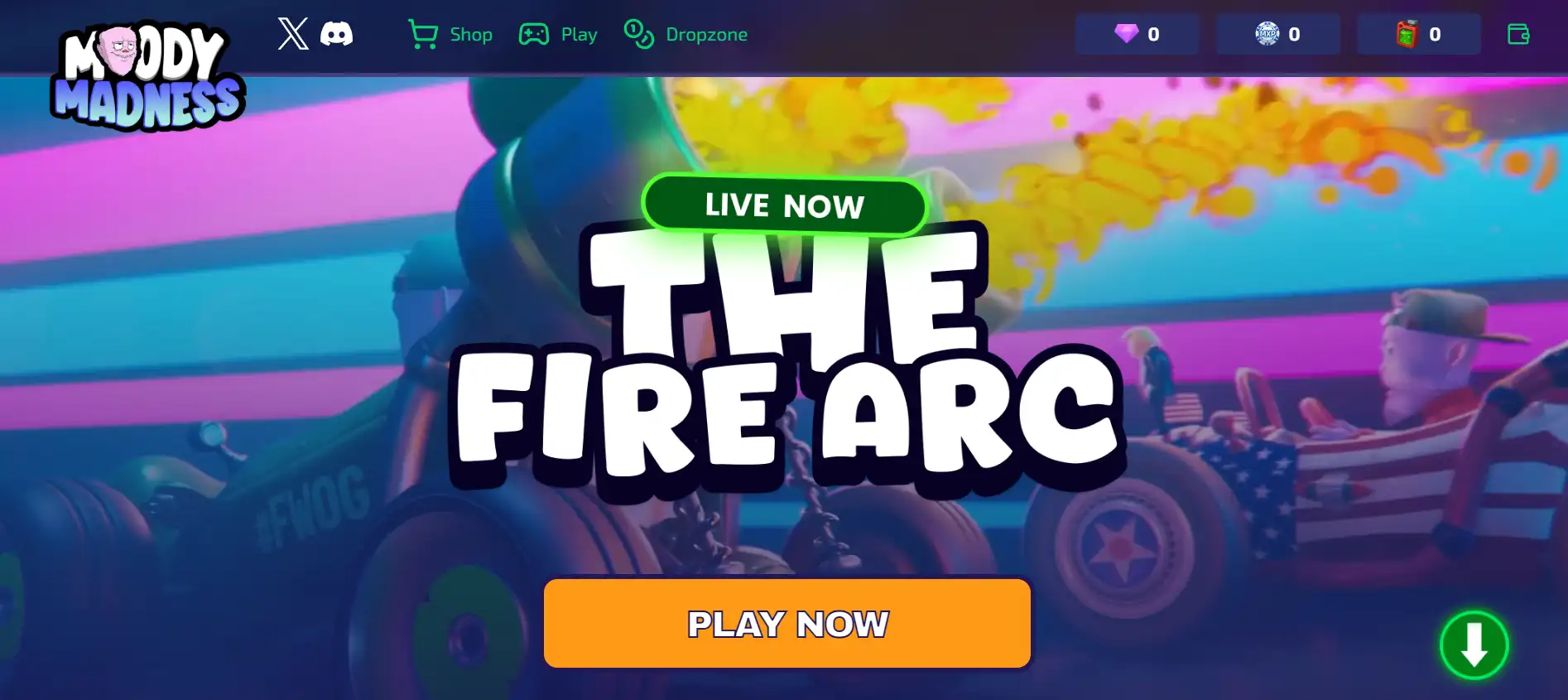Moody Madness is an exciting Web3 kart racing game built on zkSync, where speed, strategy, and blockchain innovation meet. The project offers a gasless experience thanks to the paymaster model, enables ownership of collectible NFTs, and introduces a unique AI assistant mechanic that brings chaos and excitement to every race. Let’s dive into a detailed overview.
- Introduction and Technical Features
- Gameplay: Dynamics, AI Assistants, and Modes
- NFT Economy and Trading Mechanics
- Advantages of Moody Madness
- Prospects and Ecosystem Development

Introduction and Technical Features
Moody Madness is a game by Crypto Maze built on Abstract/zkSync, combining kart racing with the benefits of Web3. With zkSync and the paymaster mechanism (such as txTsuko), players almost never face gas fees, making access significantly easier and ensuring a smooth experience for all user groups. Technically, the project uses Account Abstraction and its own paymaster to facilitate transactions and reduce transactional barriers. This makes the game accessible for beginners and scalable for large-scale activities.
Gameplay: Dynamics, AI Assistants, and Modes
The gameplay of Moody Madness is designed so that every race feels unpredictable and action-packed. Participants start simultaneously, but within seconds the match turns into a chaotic competition where success depends not only on speed but also on the ability to choose the right moment to attack or defend. The developers deliberately focus on balancing player reaction and tactical decisions to avoid monotony and keep interest over dozens of matches.
AI assistants play a special role in races and can change the outcome in just seconds:
-
Speed up your kart, helping you catch or overtake opponents.
-
Sabotage opponents by slowing them down or creating obstacles.
-
Provide temporary protection from attacks and negative effects.
These mechanics add an element of surprise, meaning even the race leader cannot be sure of victory until the very finish line. Tournament modes with leaderboards and rewards create an extra layer of competition, motivating players to improve their skills and experiment with tactics. This approach makes Moody Madness more than just an arcade racer—it’s a full-fledged esports experience in the Web3 space.
NFT Economy and Trading Mechanics
The economic model of Moody Madness revolves around tokenized assets that play a crucial role in gameplay and form the foundation of the in-game economy. NFTs in the project are not just collectible images—they are functional items that affect race outcomes, vehicle appearance, and access to special modes. Owning rare assets opens additional opportunities for customization, strategic advantages, and participation in exclusive events.
| NFT Type | Example Asset | Main Functions |
|---|---|---|
| Moody Mights | Characters / race authors | Unique heroes with bonuses and visual appeal |
| Components (assets) | Bodies, tires, spoilers | Affect characteristics and visual style |
| AI Assistants | Boosters, sabotage | Tactical functions in races |
| Special Packs | Activation packs | Starter or exclusive content access |
NFTs can be obtained through in-game mechanics such as a roulette feature or bought/sold on external marketplaces (OpenSea, Element). Prices range from around 0.0002 to 0.04 ETH, making assets accessible to both collectors and investors.
Advantages of Moody Madness
Moody Madness stands out among many Web3 games by offering players a unique combination of speed, strategy, and economic engagement. The developers focus on ensuring that users get the most from the gameplay without technical barriers or unnecessary costs. This makes the project appealing to gamers, NFT collectors, and those looking for ways to earn through gaming.
Key advantages of Moody Madness:
-
Gasless transactions — thanks to the paymaster and zkSync, users pay little or nothing for transactions.
-
Strategic unpredictability — AI assistants can change the course of races, adding a new layer of excitement.
-
NFT economy with collectible and gameplay value — Moody Mights and game assets have real value and utility.
-
Integration with the Crypto Maze / Abstract ecosystem — enabling extended cross-game functionality and event participation.
-
Scalable and accessible technical base — zkSync provides fast, low-cost transactions, and the architecture accommodates both beginners and advanced players.
These advantages create a complete ecosystem where players can develop, trade, and interact without unnecessary restrictions. Thanks to a combination of blockchain technology and well-thought-out gameplay, Moody Madness can retain its audience and encourage ongoing participation. This makes the project competitive and promising in the Web3 entertainment market.
Prospects and Ecosystem Development
Moody Madness is seen not just as a standalone game but as a foundation for creating a large-scale Web3 metaverse. In the coming years, the developers plan to expand game content by adding new tracks, unique modes, and more complex scenarios for player interaction. One of the priorities will be strengthening cross-game integration with other products in the Crypto Maze and Abstract ecosystem, enabling unified use of in-game achievements and NFTs across the network.
Special attention is also being given to competitive elements: hosting international tournaments with leaderboards and valuable prizes should attract both esports professionals and casual players eager to test their skills on a global stage. At the same time, the project will work on enabling NFT and progress transfers across various platforms, increasing their liquidity and value. Thanks to partnerships with technology providers like zkSync and TxFusion, Moody Madness already has a strong foundation for scaling, while its balanced economy and social mechanics ensure long-term community engagement.





